Teaching Biblical Allusions
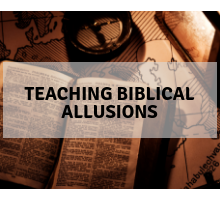
http://www.youtube.com/watch?v=eRVm_TAE24A
(Errr – don’t watch this if swearing offends you).
I’m from a very religious family. My step-dad is a former RAF Chaplain (and served in the Falkland Islands) and is now an itinerant vicar (which is not the same as what George and Lennie were); my brother is a vicar. I grew up steeped in religious tradition – from churches were the communion wine is golden to ones where they play guitars and dance. I am enduringly grateful for my upbringing. Not least when it comes to teaching literature. You see – I can spot a biblical allusion at 50 paces.
*The purpose of this introduction is to contextualise some of mild irreverence below.*
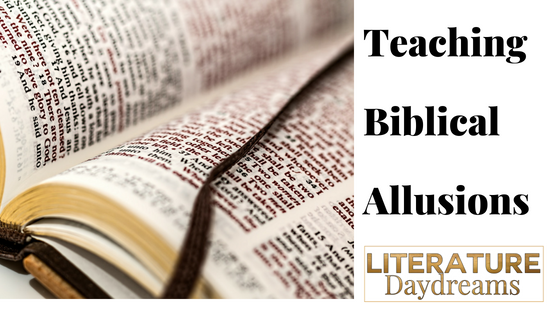
Kids these days…
Have no clue about the Bible and why should they? Yet, this absence of knowledge results in pupils often struggling to identify and understand many of the deep running threads in literature.
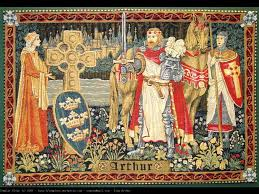
I often describe the need for deep subject knowledge as being like a tapestry – it is complex and interwoven, creating an overarching picture with mini-scenes within. Threads are drawn upon as needed but always remain embedded in and attached to the big picture.
Yet – if this tapestry is English literature – then much of what we study (if not all) was written in a time when religion and religious ideologies were key to moral and ethical outlook, social norms, thoughts on the creation of wealth, and society, and even the nature of life and death itself. Rightly or wrongly identity itself, for much of history, was shaped by religion.
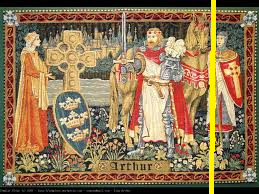
Some may disagree – but I would argue that religion was the predominant ideology of English Literature right up until World War I.
Thus over 700 years of written literature is interwoven into a tapestry where life and religion were twisted threads.
Therefore, to study, understand, and enjoy literature – knowledge of religion and the religious texts, such as the Bible, is essential.
How should we manoeuvre this camel through the needle’s eye?
It’s easy, as with all things historical context based, to bolt this knowledge onto a unit of work.
You’re teaching Great Expectations – you paraphrase the parable of the Prodigal Son.
The Lord of the Flies – well, that’s just one big Biblical allusion, although you could just summarise beginning of Genesis and then skip to the New Testament…
The Handmaid’s Tale – same.
Whilst this approach works for individual texts, it doesn’t allow students to develop an overall bank of knowledge that they can rely on. It robs them of the cultural knowledge that is part of our history, as well as our literature.
I like what ED Hirsch has to say in The Dictionary of Cultural Literacy (this is an affiliate link!):
No one in the English-speaking world can be considered literate without a basic knowledge of the Bible. … All educated speakers of American English need to understand what is meant when someone describes a contest as being between David and Goliath, or whether a person who has the “wisdom of Solomon” is wise or foolish, or whether saying “My cup runneth over” means the person feels fortunate or unfortunate. Those who cannot understand such allusions cannot fully participate in literate English.
But this piecemeal approach is not enough
Religious imagery (both positive and negative) pervades culture still. By only teaching what is needed to tackle one text, we are not weaving the tapestry.
My long-term goal is to create specific units of work that study ‘allusion’ in KS3, knowledge units that study Biblical knowledge as well as mythology from Greek, Roman, English heritage. Not just studying the stories but also studying representations of these stories, characters, and ideas throughout literature.
I’m a while away from being able to do that, so here’s the stop-gap:
At the moment, I teach these as explicit, out-of-context starters in year 9. Whilst I am aware this isn’t ideal – I do feel that some knowledge is better than none, for now.
Teaching Biblical characters who have become literary “clichés”
Here’s the list of biblical characters and stories that I teach, with some examples below:
Old Testament:
- Adam and Eve
- Satan…
- Abraham/Isaac
- Cain and Abel
- David (and Goliath)
- Jezebel
- Job
- Joseph (and his cheerful coat)
- Lot and often more importantly Lot’s Wife
- Moses
- Noah (and the Flood)
- Solomon
New Testament:
- Jesus
- John the Baptist
- Judas
- Mary (mother of Jesus)
- Peter (the rock)
- Paul (Saul)
- Pontius Pilate
- *The Holy Spirit*
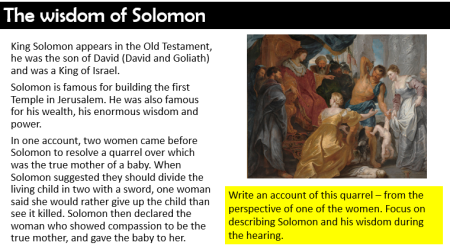
Top Bible stories to know:
Old Testament:
- Creation – Genesis 1 and 2, Adam & Eve, the apple, the snake, the Garden of Eden etc
- Cain & Abel – the first death, the first murder
- The Flood – the rain, the boat, the animals, the rainbow, the dove.
- Jonah and the whale – I didn’t put Jonah as a character above because his story isn’t really all that without the whale. It’s a great narrative about rebellion, trust, and redemption.
- The Tower of Babel – the arrogance of man and the birth of language.
- Moses and the Ten Commandments – what happens at the top of the mountain and what happens when you get down again.
- Job – misery loves company.
New Testament:
- The birth of Jesus – rather than the nativity itself, I tend to focus on King Herod and the baby genocide, the astronomers and following a star and then the idea of the birth of a new humanity and the age of harmony with God.
- The story of John the Baptist (or ‘always the bridesmaid, never the bride’)
- The Beatitudes
- The Good Samaritan
- The resurrection of Lazarus
- The Parable of the Prodigal Son
- The “Let he who has no sin cast the first stone” story
- The betrayal of Judas
- The Crucifixion and Resurrection – again, where my students have the basic knowledge from their Religious Studies lessons, I tend to look at nature imagery and Christ figures.

Even more…
Also because Biblical allusion, among other things, is tested under the AP Literature curriculum – there are loads of fabulous sites that have lists of biblical phrases etc. I like this PDF because it has a bunch of useful literary, biblical and historical allusions.
What to test your knowledge of Biblical reference and allusion? Have a go at this BBC quiz!
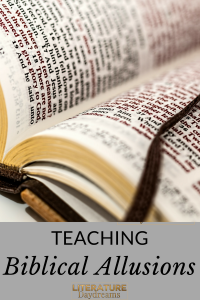

Subscribe to my weekly teaching tips email!
Sign up below to receive regular emails from me jammed packed with ELA teaching tips, tricks and free resources. Also access my free resource library!

